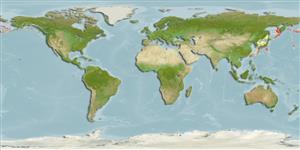>
Perciformes/Cottoidei (Sculpins) >
Liparidae (Snailfishes)
Etymology: Careproctus: Greek, kara = face + Greek, proktos = anus (Ref. 45335); lycopersicus: Named for the tomato plant, Solanum lycopersicum, meaning ‘wolf peach'; referring to its typically bright red tomato-like coloration..
Environment: milieu / climate zone / depth range / distribution range
Ecología
marino batidemersal; rango de profundidad 397 - 1157 m (Ref. 91047). Temperate
Distribución
Países | Áreas FAO | Ecosistemas | Ocurrencias, apariciones | Point map | Introducciones | Faunafri
North Pacific: Bering Sea and the eastern Aleutian Islands.
Tamaño / Peso / Age
Maturity: Lm ? range ? - ? cm
Max length : 13.3 cm TL macho / no sexado; (Ref. 91047); 17.2 cm TL (female)
Short description
Morfología | Morfometría
Radios blandos dorsales (total): 42-45; Radios blandos anales: 34 - 38; Vértebra: 45 - 50. This species is distinguished from its congeners by the following characters: premaxilla and dentary with broad rows of strongly trilobed teeth (vs. simple or weakly trilobed teeth on both jaws); the large gill opening extends ventrally to pectoral rays 8-12 (vs. smaller above the pectoral fin or extending to less than five pectoral-fin rays); large pelvic disk greater or equal 30% head length (vs. smaller pelvic disk, < 25% HL); most similar to C. ovigerus, which can be distinguished from C. lycopersicus by its simple, canine teeth on both jaws, and to C. kamikawai, which is distinguished by its subterminal mouth, slight dorsal-fin lobe, black peritoneum, smaller pelvic disc, slender caudal base, and more anterior position of the pelvic disc, anus, and anal-fin origin (Ref. 91047).
One 11.6 cm TL ripe male and female specimens were examined: the smallest female with yolked eggs was 14.9 cm (UW 119817). For the ripe females, at least two sizes of eggs were present, yolked eggs were 3.5 mm in diameter and smaller white eggs had diameters of 0.5-1.5 mm (Ref. 91047).
Life cycle and mating behavior
Madurez | Reproducción | Puesta | Huevos | Fecundidad | Larva
Orr, J.W., 2012. Two new species of snailfishes of the genus Careproctus (Scorpaeniformes: Liparidae) from the Bering Sea and Eastern North Pacific Ocean, with a redescription of Careproctus ovigerus. Copeia 2012(2):257-265. (Ref. 91047)
IUCN Red List Status (Ref. 130435)
Threat to humans
Harmless
Human uses
Más información
PaísesÁreas FAOEcosistemasOcurrencias, aparicionesIntroduccionesStocksEcologíaDietacomponentes alimenticiosconsumo de alimentoRación
Nombres comunesSinónimosMetabolismoDespredadoresEcotoxicologíaReproducciónMadurezPuestaAgregación para la puestaFecundidadHuevosEgg development
Age/SizeCrecimientoLength-weightLength-lengthLength-frequenciesMorfometríaMorfologíaLarvaDinámica larvariaReclutamientoAbundanciaBRUVS
ReferenciasAcuiculturaPerfil de acuiculturaRazasGenéticaElectrophoresesheritabilidadEnfermedadesProcesamientoNutrientsMass conversion
ColaboradoresImágenesStamps, Coins Misc.SonidosCiguateraVelocidadTipo de nataciónSuperficie branquialOtolitosCerebrosVisión
Herramientas
Special reports
Download XML
Fuentes de Internet
Estimates based on models
Preferred temperature (Ref.
123201): 2 - 3.5, mean 3.3 °C (based on 22 cells).
Phylogenetic diversity index (Ref.
82804): PD
50 = 0.5000 [Uniqueness, from 0.5 = low to 2.0 = high].
Bayesian length-weight: a=0.00447 (0.00204 - 0.00980), b=3.17 (2.99 - 3.35), in cm total length, based on LWR estimates for this Genus-body shape (Ref.
93245).
Nivel trófico (Ref.
69278): 3.2 ±0.5 se; based on size and trophs of closest relatives
Resiliencia (Ref.
120179): Alto, población duplicada en un tiempo mínimo inferior a 15 meses (Preliminary K or Fecundity.).
Fishing Vulnerability (Ref.
59153): Low vulnerability (10 of 100).
